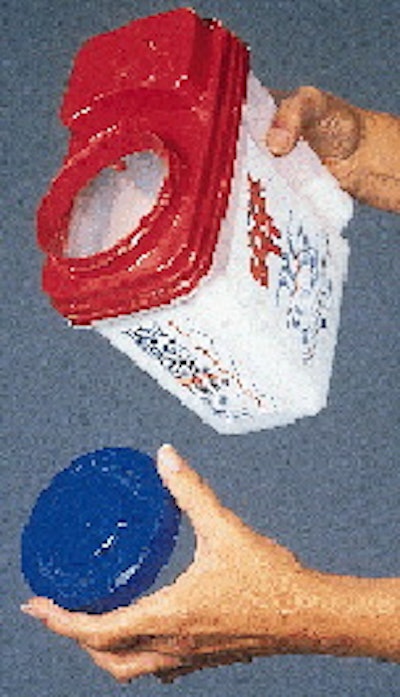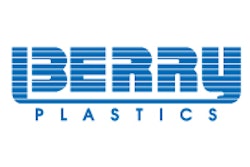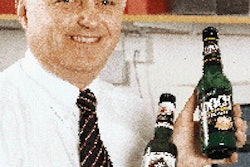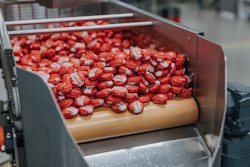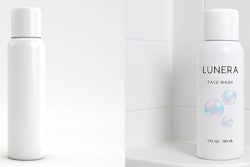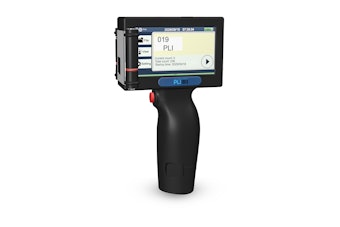A determined marketer, creative container designers and a savvy injection molder all teamed up to produce four new high-density polyethylene containers for Olin's popular hth® and pace® lines of home pool chemical cleaners in granular and tablet forms. These square containers replace a variety of round jars and buckets. The new containers are now on the shelf in some Wal-Mart outlets and will be rolled out into other Wal-Marts and other stores as the pool season begins. All of the containers are molded by Berry Plastics (Evansville, IN) from designs developed by Olin and Studio Plus (Hauppauge, NY). The four sizes are referred to by the nominal weights they hold: five, 15, 25 and 50 lb. Along with molding and assembling, Berry also handles decorating. Each container is four-side decorated by Dinacal® gravure-printed heat-transfer labels supplied by Dinagraphics Div., Jefferson Smurfit Corp. (Cincinnati, OH). Berry operates two decorating lines supplied by Tronics America (Merrillville, IN) using equipment designed in Australia. The four containers in the Olin modular system offer numerous features for Olin, for retailers and for consumers. The injection-molded square containers were designed with bases and tops that permit stacking and interlocking, not possible with the previous round containers. These features offer versatility to the manufacturer in shipping pallet loads of mixed products and mixed sizes. They also help retailers create space-saving displays. Since some of the pool products contain hazardous Class III oxidizers, the containers had to be designed to ensure that all of the product could be easily removed by the consumer. This is accomplished by the internal design of the base and a special collar at the top that creates an interference on the outer perimeter of the container to help ensure granular product won't collect in corners. The collar is sonically sealed to the inside of what Olin calls the "housing," the red or orange top that serves as a platform for the cap. The housing and collar are friction-fitted onto the base. The large-diameter cap, or lid, also works with threads molded into the housings to make all of the containers child-resistant and senior-friendly. Berry has already been granted a mechanical patent on this design. In addition, the housings for the three larger sizes are molded with finger grips on two opposing sides to allow store personnel and consumers to more easily lift the containers. On the smallest container, a hand grip is molded into one side for handling. On the largest and heaviest container, polypropylene wheels and handle allow rolling of the package both in the store and at home. Finally, the three larger sizes are all U.S. Dept. of Transportation-approved as stand-alone packages, and all are United Nations-approved for shipment of hazardous materials. 'Bulldog' determination This sweeping repackaging project began when Aleene Nask, a new marketing person at Olin, visited retailers to do "store sets," arranging the company's products in a predetermined Planogram. One day, recalls Nask, "A store manager walked up and pointed to the display. 'I can't sell that air!' he grumbled, referring to the open space between the round containers. "I was so embarrassed. But from that day forward that 'air' has been on my mind. And how to move Olin forward into a package that didn't require retailers to sell 'air.' That's what drove this project," she says. That incident occurred about five years ago. Nask is now manager of marketing services for Norwalk, CT-based Olin, with some packaging responsibilities. To eliminate the "air" problem, Nask had to find a cooperative package designer, a container supplier, and decorating suppliers. Then she had to persuade management to invest in an undertaking of this size. In the end, she says, the impetus came from Olin's production and packaging plant<>but in a round-about way. The project "really gained momentum," says Nask, when the company realized that newer, faster packaging lines in the plant were needed. Since Olin had already planned to invest in new equipment, it seized the opportunity to change its packages and its packaging equipment together. In addition, Nask had taken the new package concept to some retail customers who became very interested in how the containers could conserve selling space. Berry commits, too About three years ago, Nask began talking about the concept to major packaging suppliers to see what they were working on and to arouse their interest. Although they showed her some ideas, none was as dramatic as what she envisioned. She even contacted household container marketer Tupperware. At the time, she says, they weren't interested in working on designs with other companies. "We also felt they might be too expensive as a supplier," she adds. Eventually she discovered Rich Rhodes at Studio Plus, a small design studio specializing in graphics. "I explained that I felt there would be a way to make these packages look like Legos, so we could stack them easily in columns or cross-stacking. The goal was to be able to pack a variety of products onto a pallet or shelf with the same height. After months of refining designs and developing colors, we ended up with some excellent drawings and models of a family of packages," Nask recalls. Once Olin management gave the green light, the project stalled until a supplier could be found. "This was a huge undertaking for Berry, and they were the only vendor that would work with us on this," Nask says. And she admits that converting the concept into real containers was a major challenge for Berry designer Tim Willett. "This was one of the largest projects Berry Plastics has ever undertaken," Willett says. "We've been working on the designs for about two years." CR feature wins patent While Berry began to develop structural container designs, the company also had to make the containers easy to open yet capable of passing child-resistance and senior-friendly protocol testing. "Our patent covers the locking feature of the lid," says Willett. "It covers the design of the lid with the locking feature and the housing with the thread that makes it work. My understanding is that we have the only container that not only passes CR and senior-friendly protocols, but also the UN and DOT tests." Similarly, Olin began an exhaustive research project to make sure the new designs would meet the needs of retailers and satisfy consumers as well. The company also wanted to ensure that the new packages wouldn't disappoint customers that liked the existing packs. In part, this research helped the company develop new instructions and pictographs for the decorating graphics that were easier to understand by consumers. All the parts are molded of standard HDPE resin except for the collar. It's a thermoformed part that's made from a special fractional-melt resin and produced for Berry by an outside supplier, Willett tells Packaging World. The collar design was a group effort at Berry. "It's sonically welded to the housing. "Producing these parts was difficult to learn," he notes. "Designing the tooling for all these features had never been done before. So there was a learning curve on this, and we're still learning. After all, we just began producing these a few months ago, so we're still tweaking the process." Australian decorating equipment Olin purchased the two Tronics decorating lines that Berry uses to apply the heat-transfer decorating. The equipment is believed to be the only machinery available that can apply heat-transfer labels large enough for these square containers, says Julie Jacobs, a project engineer at Berry. The largest containers are decorated with labels that measure 91/2 x 7" W (live copy area), and an earlier version was 2" taller. The key, she says, is the square shape. Other equipment can apply this type of decorating to large pails. But the Tronics equipment is significantly larger. The square shape presents unusual decorating problems because when the containers cool, they shrink a lot differently than do round containers. This creates a lot of variability in the sidewalls, Jacobs says. Like conventional heat-transfer decorating equipment, the Tronics equipment first pre-flames the label area to promote adhesion. The gravure-printed decoration unwinds from a roll and is applied to the container before the decorating surface is post-flame-treated for gloss and adhesion. At the point of application, Jacobs says there is some container inflation to help stiffen and vertically straighten the sidewalls. "There are also some proprietary steps in our process to make it work," she adds. Each line has two sets of application heads. Each set applies the decorating to two opposing panels. All four panels are decorated in a single pass through each of the decorating lines. The equipment is flexible. One decorating line is devoted to the three largest container sizes, the other handles the two smaller sizes. Both lines can run the 15-lb size container. "There is quite a bit of versatility in the vertical direction on the equipment. We can lengthen the rollers when we decorate the largest containers," says Jacobs. Like the containers themselves, decorating is costly. Olin declined to discuss comparative economics. However, each separate six-color gravure label is printed with special chlorine gas-proof inks. On the 15-lb container, one of the four panels is decorated with one pressure-sensitive label, due to the requirements of the label size and its placement tolerance. Jacobs says the plant is very cautious about label accuracy. Plant input helpful Unlike some marketing people, Olin's Nask is mindful of the importance of having production and packaging support for a new package. So when the company realized it needed to revamp its own packaging lines, one of the plant's packaging people came to headquarters to help Nask organize and implement the details. "That was a little insurance so that there would be no surprises when we got to the end of the project," she says. "We know that sometimes marketing departments can design packages that can be tough to fill and close. On this project, we involved the plant packaging people about the time we made the commitment." Olin's plant in Charleston, TN, began filling the new containers in November. Since the product is seasonal, Olin geared up for spring distribution. One promotional device that Olin is using shows a 4' planogram of the former packages and a planogram of the new modular square containers. "With the new containers, we actually put forty percent more product on the shelf than we did before," Nask reports. The new family of sizes has cut Olin's number of SKUs as well. It reduced the number of packages of primary sanitizer products by 30%, and probably reduced total SKUs by about 40%. In the future, the modularity of the containers will permit Olin to ship mixed pallet loads to customers, especially to replenish stocks. "We want to get into mixed loads," Nask says with enthusiasm. "Until now, the variety of sizes and shapes just hasn't permitted it. Containers simply didn't stack before." The same is true for secure loads in trucks and even in sea cargo containers, Nask notes. The response from retailers has been "incredible," and not just from Wal-Mart. The new containers have allowed Olin to retain some accounts it might have lost with its previous packaging. "This just all stems from what I learned from our customers," Nask points out. "It truly gives us a major edge in our product category, and in the retail environment." And, she concludes, "I don't look at containers in the same way anymore."
